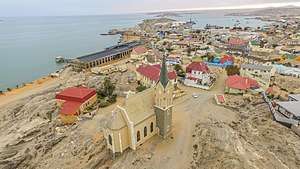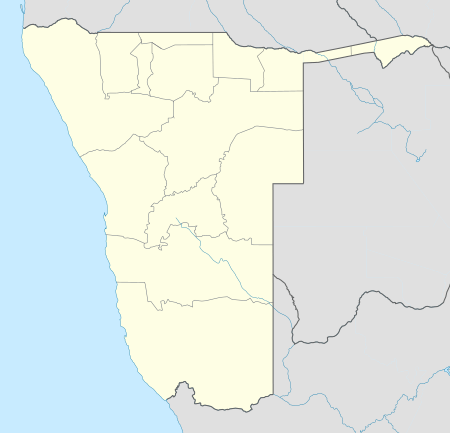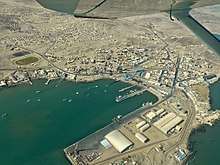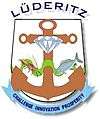Lüderitz
| Lüderitz | ||
|---|---|---|
| Town | ||
 An aerial view of Lüderitz with the Felsenkirche in the foreground and the rest of the town in the background | ||
| ||
| Motto(s): Challenge, Innovation, Prosperity | ||
 Lüderitz Location in Namibia | ||
| Coordinates: 26°38′45″S 015°09′14″E / 26.64583°S 15.15389°ECoordinates: 26°38′45″S 015°09′14″E / 26.64583°S 15.15389°E | ||
| Country |
| |
| Region | ǁKaras Region | |
| Constituency | ǃNamiǂNûs Constituency | |
| Established | 1883 | |
| Government | ||
| • Mayor | Hambelela Suzan Ndjaleka[1] | |
| Population (2011)[2] | ||
| • Total | 12,537 | |
| Time zone | UTC+2 (SAST) | |
| Climate | BWk | |
| Website |
luderitz-tc | |

Lüderitz is a harbour town[3] in the ǁKaras Region of southern Namibia, lying on one of the least hospitable coasts in Africa. It is a port developed around Robert Harbour and Shark Island.
The town is known for its colonial architecture, including some Art Nouveau work, and for wildlife including seals, penguins, flamingos and ostriches. It is also home to a museum, and lies at the end of a currently decommissioned railway line to Keetmanshoop.
History
The bay on which Lüderitz is situated was first known to Europeans when Bartolomeu Dias encountered it in 1487. He named the bay Angra Pequena (Portuguese: Small Bay) and erected a padrão (stone cross) on the southern peninsula. In the 18th century Dutch adventurers and scientists explored the area in search of minerals but did not have much success. Further exploration expeditions followed in the early 19th century during which the vast wildlife in the ocean was discovered. Profitable enterprises were set up, including whaling, seal hunting, fishing and guano-harvesting. Lüderitz thus began its life as a trading post.[4]
The town was founded in 1883 when Heinrich Vogelsang purchased Angra Pequena and some of the surrounding land on behalf of Adolf Lüderitz, a Hanseat from Bremen in Germany, from the local Nama chief Josef Frederiks II in Bethanie. When Adolf Lüderitz did not return from an expedition to the Orange River in 1886, Angra Pequena was named Lüderitzbucht in his honour.[4] In 1905, German authorities established a concentration camp on Shark Island. The camp, access to which was very restricted, operated between 1905 and 1907 during the Herero Wars. Between 1,000 and 3,000 Africans from the Herero and Nama tribes died here as a result of the tragic conditions of forced labour. Their labour was used for expansion of the city, railway, port and on the farms of white settlers.[5][6][7]
In 1909, after the discovery of diamonds nearby, Lüderitz enjoyed a sudden surge of prosperity due to the development of a diamond rush to the area. In 1912 Lüderitz already had 1,100 inhabitants, not counting the indigenous population. Although situated in harsh environment between desert and Ocean, trade in the harbour town surged, and the adjacent diamond mining settlement of Kolmanskop was built.[8]
After the German World War I capitulation South Africa took over the administration of German South West Africa in 1915. Many Germans were deported from Lüderitz, contributing to its shrinking in population numbers. From 1920 onwards, diamond mining was only conducted further south of town in places like Pomona and Elizabeth Bay. This development consequently led to the loss of Lüderitz' importance as a trading place. Only small fishing enterprises, minimal dock activity and a few carpet weavers remained.[8]
In an effort to remove colonial names from the maps of Namibia, in 2013 the Namibian government renamed the constituency ǃNamiǂNûs, its name prior to 1884.[9][10]
Geography
.jpg)
The harbour has a very shallow rock bottom, making it unusable for modern ships; this led to Walvis Bay becoming the centre of the Namibian shipping industry. Recently, however, the addition of a new quay has allowed larger fishing vessels to dock at Lüderitz. The town has also re-styled itself in an attempt to lure tourists to the area, which includes a new waterfront area for shops and offices.
Just outside Lüderitz lies the ghost town of Kolmanskop, a prominent tourist destination. This previously bustling diamond town is now abandoned, and fights a constant struggle against being buried under the shifting sand dunes of the Namib desert.
Conservation
.jpg)
The coastline in the area is recognised by Bird Life and other global conservation groups as one of the Important Bird Areas (IBAs) for important coastal seabird breeding.
Mercury Island, Ichaboe Island, Halifax Island and the Possession Islands support the entire Namibian breeding population of Cape gannets (Morus capensis), 96% of the Namibian population of the endangered African penguin (Spheniscus demersus), and nearly one quarter of the global breeding population of crowned cormorants (Microcarbo coronatus).[11]
Approximately 80% of the global population of the endangered Bank cormorant (Phalacrocorax neglectus) breeds on Mercury Island and in the Ichaboe Islands.
In April 2009, an oil spill from an oil tanker risked hundreds of African penguins and other flora and fauna.
Several species of cetaceans, most notably Haviside's dolphins, can be seen close to the shore while larger whales such as southern right,[12][13] humpback, minke, fin, pygmy right, are less common but gradually increasing in numbers.
Climate
Lüderitz has a mild desert climate (BWn, according to the Köppen climate classification), with moderate temperatures throughout the year. The average annual precipitation is 17 millimetres (0.67 inches). Windy and cold conditions can occur due to the cold South Atlantic current on the coast.
| Climate data for Lüderitz | |||||||||||||
|---|---|---|---|---|---|---|---|---|---|---|---|---|---|
| Month | Jan | Feb | Mar | Apr | May | Jun | Jul | Aug | Sep | Oct | Nov | Dec | Year |
| Record high °C (°F) | 32.5 (90.5) |
30.0 (86) |
34.1 (93.4) |
36.5 (97.7) |
33.0 (91.4) |
31.6 (88.9) |
30.7 (87.3) |
33.0 (91.4) |
35.1 (95.2) |
35.0 (95) |
37.5 (99.5) |
30.6 (87.1) |
37.5 (99.5) |
| Average high °C (°F) | 21.4 (70.5) |
21.3 (70.3) |
21.1 (70) |
19.9 (67.8) |
19.2 (66.6) |
19.0 (66.2) |
17.9 (64.2) |
17.2 (63) |
17.3 (63.1) |
18.0 (64.4) |
19.2 (66.6) |
20.5 (68.9) |
19.3 (66.7) |
| Daily mean °C (°F) | 17.7 (63.9) |
17.8 (64) |
17.4 (63.3) |
16.3 (61.3) |
15.5 (59.9) |
15.1 (59.2) |
14.1 (57.4) |
13.7 (56.7) |
13.9 (57) |
14.7 (58.5) |
15.8 (60.4) |
17.0 (62.6) |
15.7 (60.3) |
| Average low °C (°F) | 14.0 (57.2) |
14.3 (57.7) |
13.8 (56.8) |
12.6 (54.7) |
11.7 (53.1) |
11.2 (52.2) |
10.4 (50.7) |
10.2 (50.4) |
10.5 (50.9) |
11.4 (52.5) |
12.3 (54.1) |
13.5 (56.3) |
12.1 (53.8) |
| Record low °C (°F) | 5.5 (41.9) |
5.0 (41) |
6.0 (42.8) |
5.5 (41.9) |
3.3 (37.9) |
0.2 (32.4) |
3.0 (37.4) |
4.8 (40.6) |
3.4 (38.1) |
3.4 (38.1) |
4.9 (40.8) |
3.9 (39) |
0.2 (32.4) |
| Average precipitation mm (inches) | 0 (0) |
1 (0.04) |
2 (0.08) |
2 (0.08) |
3 (0.12) |
3 (0.12) |
1 (0.04) |
2 (0.08) |
1 (0.04) |
0 (0) |
0 (0) |
0 (0) |
17 (0.67) |
| Average precipitation days (≥ 0.1 mm) | 1.0 | 1.0 | 1.0 | 0.9 | 1.4 | 1.4 | 1.0 | 0.7 | 0.5 | 0.5 | 0.5 | 0.7 | 10.6 |
| Average relative humidity (%) | 82 | 81 | 82 | 80 | 79 | 72 | 74 | 78 | 80 | 80 | 80 | 80 | 79 |
| Mean monthly sunshine hours | 198.4 | 203.4 | 257.3 | 216.0 | 213.9 | 144.0 | 170.5 | 201.5 | 216.0 | 201.5 | 189.0 | 176.7 | 2,388.2 |
| Mean daily sunshine hours | 6.4 | 7.2 | 8.3 | 7.2 | 6.9 | 4.8 | 5.5 | 6.5 | 7.2 | 6.5 | 6.3 | 5.7 | 6.5 |
| Source: Deutscher Wetterdienst[14] | |||||||||||||
Sport
Lüderitz is home to the Lüderitz Speed Challenge, the only international sporting event held in the town. This is an annual month-long speed sailing event held in the last quarter of the year under the auspices of the International Sailing Federation (ISAF) World Sailing Speed Record Council (WSSRC).[15]
In 1984 Lüderitz was the starting point for explorer and sailor Amyr Klink's successful solo crossing of the Atlantic Ocean, rowing for 101 days all the way to the Brazilian coast with no other form of propulsion.[16]
In October 2011, Turkish-born American adventurer Erden Eruç departed from Lüderitz Bay for the final ocean crossing of his Guinness world record-setting solo human-powered circumnavigation of the Earth.[17] Eruç rowed to South America in an oceangoing rowboat, taking five months for the crossing to the town of Güiria, Venezuela.[18]
Economy and infrastructure
Construction of a new port at Shearwater Bay, 30 kilometres (19 miles) south of Lüderitz, has been proposed for the export of coal from Botswana with a 1,600-kilometre (990-mile) railway connecting the two.[19]
Lüderitz is the terminus of the 318 kilometres (198 mi) railway line to Seeheim where the railway connects to the rest of the country's network. This line, built by inmates of the concentration camp on Shark Island, was completed in 1908[20] but is currently not operational. Rebuilding of a remaining 47 kilometres (29 mi) track gap to Aus has been delayed since 2009.
Media
Lüderitz has a local monthly newspaper, Buchter News. The paper, which was started as a source of free English-language reading material, is run by volunteers from the British gap year charity Project Trust.
Politics
Lüderitz is governed by a town council that currently has seven seats.[21]
The 2015 local authority election was won by SWAPO which gained six seats (2,679 votes). The remaining seat went to the Democratic Turnhalle Alliance (DTA) with 265 votes.[22]
Cooperation agreements
Lüderitz is twinned with:

Education
Previously the German school Deutsche Schule Lüderitzbucht was in the city. In 1965 it had 13 teachers and 140 learners and was supported by German government.[24]
Landmarks
 View of Felsenkirche and Lüderitz |
- Deutsche Afrika Bank building, erected 1907, national monument[25]
- Felsenkirche (English: Rock Church) on Diamond Hill, a church in vertical gothic style consecrated in 1912. After the diamond rush of 1908 and the completion of the railway line to Keetmanshoop Lüderitz became permanently home to a significant white population. As a result, a number of churches were built. Felsenkirche, one of the oldest Lutheran churches in Namibia, has been a national monument since 1978.[26]
- Glück Auf building, built 1907/08 for a lawyer of the diamond companies, declared a national monument in 2014[25]
- Goerkehaus, the residence of Hans Goerke, manager and co-owner of the early diamond umbrella company, erected 1909–1911,[4] national monument[25]
- Kreplinhaus, the residence of the first mayor, Emil Kreplin, built in 1909,[4] national monument[25]
- Krabbenhöft & Lampe building, after co-owners Friedrich Wilhelm Krabbenhöft and Oscar Lampe. The predecessor of this business, the Handelsstation F.W. Krabbenhöft in Keetmanshoop, existed since 1880 and was one of the first formally registered businesses in South West Africa. Erection of the building started in late 1909, and has been a national monument since 1979.[27]
- Lüderitz Railway Station, erected in 1904,[4] is also a national monument. [25]
 Goerke Haus
Goerke Haus Kapps-Ballsaal with Felsenkirche and Goerke Haus in background
Kapps-Ballsaal with Felsenkirche and Goerke Haus in background Bergstraße
Bergstraße.jpg) Woermannhaus (2017)
Woermannhaus (2017)
External links
| Wikimedia Commons has media related to Lüderitz. |
References
Notes
- ↑ Respect the elderly: Lüderitz mayor Archived 16 May 2012 at the Wayback Machine. The Namibian, 7 January 2011
- ↑ "Table 4.2.2 Urban population by Census years (2001 and 2011)" (PDF). Namibia 2011 – Population and Housing Census Main Report. Namibia Statistics Agency. p. 39. Retrieved 24 August 2016.
- ↑ "Lüderitz...the Diamond of Namibia!". luderitz-tc.com.
- 1 2 3 4 5 von Schmettau, Konny (28 February 2013). "Lüderitzbucht: Gründer- und Diamantenstadt" [Lüderitzbucht: Town of Pioneers and Diamonds]. Allgemeine Zeitung (in German). Tourismus Namibia monthly supplement. p. 6.
- ↑ Zimmerer & Zeller 2003, p. 80.
- ↑ Overmans, Rüdiger (1999). In der Hand des Feindes : Kriegsgefangenschaft von der Antike bis zum Zweiten Weltkrieg (in German). p. 291.
Die Verhältnisse in Swakopmund, zu denen sich Tecklenburg äußerte, stellten keine Ausnahme dar. Noch schlimmer lagen die Verhältnisse im Konzentrationslager auf der Haifischinsel vor Lüderitzbucht, dem größten Gefangenenlager. Dort wurden sowohl Herero wie Nama interniert und ihrem Schicksal überlassen. Die Inhaftierung auf de." reprinted in Jürgen Zimmerer Deutsche Herrschaft über Afrikaner: Staatlicher Machtanspruch und ... (2004). Page 46.
- ↑ Erichsen 2005, pp. .
- 1 2 "Unverwüstliche Felsenkirche zwischen Wüste und Meer" [Indestructible Rock Church between Desert and Ocean]. Gondwana History (in German). supplement to various Namibian newspapers (92).
|access-date=requires|url=(help) - ↑ "Namibia renames Caprivi Strip". news24.com.
- ↑ Nakale, Albertina (9 August 2013). "President divides Kavango into two". New Era.
- ↑ "Walk on our coastline". Namibian Coast Conservation and Management Project (NACOMA). Archived from the original on 21 July 2009. Retrieved 21 October 2008.
- ↑ The Namibian Sun. 2013. Southern right whale – The right whale to protect. Retrieved on 24 October 2015
- ↑ Travel News Namibia. 2012. The return of the whales. Retrieved on 24 October 2014
- ↑ "Klimatafel von Lüderitz-Diaz Point (Leuchtturm) / Namibia" (PDF). Baseline climate means (1961–1990) from stations all over the world (in German). Deutscher Wetterdienst. Retrieved 29 March 2016.
- ↑ "World's best at Luderitz Speed Challenge | Sailing News". Seabreeze.com.au. 13 October 2008. Retrieved 24 April 2012.
- ↑ "O herói do Atlântico" (in Portuguese). Retrieved 11 October 2008.
- ↑ "Guinness World Records – First solo circumnavigation of the globe using human power". Guinness World Records. Archived from the original on 19 March 2016. Retrieved 16 January 2016.
- ↑ "Media Kit – Project Summary Document" (PDF). Around-n-Over (PDF file linked from "around-n-over.org/media/mediakit.htm"). 22 August 2012. Archived (PDF) from the original on 14 February 2016. Retrieved 11 November 2016.
- ↑ Africa News | Railways Africa
- ↑ Dierks, Klaus. "The Development of the Namibian Railway Network. The Rail History Until the 1990s". www.klausdierks.com. Retrieved 6 November 2012.
- ↑ "Know Your Local Authority". Election Watch (3). Institute for Public Policy Research. 2015. p. 4.
- ↑ "Local elections results". Electoral Commission of Namibia. 28 November 2015. p. 3. Archived from the original on 10 December 2015.
- ↑ https://www.t-online.de/nachrichten/id_83671432/altmark-ort-luederitz-knuepft-freundschaftsband-nach-namibia.html
- ↑ "Deutscher Bundestag 4. Wahlperiode Drucksache IV/3672" (Archive). Bundestag (West Germany). 23 June 1965. Retrieved on 12 March 2016. p. 32.
- 1 2 3 4 5 Tjihenuna, Theresia (2 September 2014). "Three new heritage sites proclaimed". The Namibian.
- ↑ Bause, Tanja (21 May 2012). "Lüderitz church celebrates centenary". The Namibian.
- ↑ Becker, Klaus J. (25 May 2015). "Neuer Eigner übernimmt 135 Jahre alte Firma" [New owner takes over 135-year-old company]. Allgemeine Zeitung (in German).
Literature
- Erichsen, Casper W. (2005). The angel of death has descended violently among them: Concentration camps and prisoners-of-war in Namibia, 1904–08. Leiden: University of Leiden African Studies Centre. ISBN 90-5448-064-5.
- Zimmerer, Jürgen; Zeller, Joachim (2003). Völkermord in Deutsch-Südwestafrika: Der Kolonialkrieg 1904 – 1908 [Genocide in German South West Africa: The Colonial War 1904–1908] (in German).
